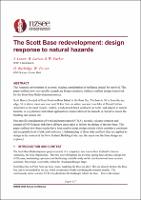The Scott Base Redevelopment: design response to natural hazards

Download
Date
2020-04-22Authors
Lester, Jamie
Larson, B.
Parker, Will
Burbidge, David
Power, William
Metadata
Show full item recordAbstract
The Antarctic environment is extreme, making consideration of resilience crucial for survival. This paper outlines how site-specific hazards are being considered within a resilient design framework for the Scott Base Redevelopment project.
Scott Base is located at Pram Point on Ross Island in the Ross Sea. The base is 30 m from the sea edge, 16 m above mean sea level and 38 km from an active volcanic lava lake at Mount Erebus. Antarctica is the most remote, coldest, windiest and driest continent on Earth, and subject to natural hazards, so a systematic and robust approach to consideration of the hazards is crucial to ensure the building can sustain life.
Site specific consideration of wind and temperature (NIWA), seismic, volcanic eruption and tsunami (GNS Science) risks have all been undertaken to inform the design of the new base. This paper outlines how these studies have been used to adopt design criteria which consider a consistent and acceptable level of risk and resilience. Understanding of these risks and how they are applied to design in the context of the New Zealand Building Code, and the impact on the Base design are explored.
